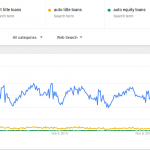Automotive Debt Statistics
Automotive Debt Statistics 2022-2023

Automotive Debt Statistics 2022-2023
- Auto loan debt is the third-largest debt consumer have, behind mortgages and student loan debt.
- The average car loan debt for a new car is $648 monthly in 2022.
- Total consumer vehicle debt in Q2 is $1.50 trillion.
- Borrowers with prime credit scores account for 65.2% of retail vehicle financing.
- The average term for a new car loan in 2021 for super prime borrowers was 69.47 months.
- Vehicle loan delinquencies were up 2.9% in January 2022 from one year ago.
- The annual repossession rate is around 65% for all the vehicles sold.
- In Q1 2022, credit unions accounted for 22.06% of the vehicle finance market.
- The average new car loan for borrowers with a credit score of 750 or higher in 2022 is 7.93%.
Automotive Debt Facts 2022-2023
Besides mortgages, most consumers have student loan debt and car loan debt and auto loan debt. Car loan debt comes in third by dollar amount, but only by one percentage point. This is because of higher car prices and high interest rates for consumers with less than perfect credit. Unfortunately, many people need an auto. There may not be public transportation in the area they live. Certain workers also need their own transportation, like real estate agents and contractors who need to bring tools to jobs. When a couple has all three debts, including double student loan payments and two auto loans, it can wreak havoc on their budget if one person loses their job or becomes ill.
Financed new cars cost on average $648 per month in 2022. Naturally, there are many factors that determine your monthly payment, including the length of the loan, the price of the car and your interest rate. Your interest rate is determined by your credit score. Having good credit can save you a lot of money. Taking out a longer term loan can also save you money, but you risk your auto not being worth what’s left on the loan.
In the second quarter of 2022, Americans owed $1.50 trillion in vehicle debt. Two of the top three credit reporting agencies, Equifax and TransUnion, say the low-income and young people are struggling with auto loans now. Extra unemployment benefits, stimulus checks and other government benefits are over. Many auto lenders are eager to repossess the vehicles, as for the first time in many years, vehicles are appreciating in value. People living paycheck to paycheck may find it difficult to keep up with their car payments.
Automotive Debt Statistics 2022-2023
Consumers with prime credit scores account for 65.2% of vehicle financing. Prime credit scores are between 661 and 719, depending on the lender. A perfect credit score is 850. There are also super prime credit scores. Consumers with prime or super prime credit get the lowest interest rate on vehicles. The average credit score for American consumers is 711. Generation Z (ages 18 to 23) consumers who want to borrow money for a vehicle typically have the lowest credit scores, with an average of 674. This may account for why many young adults ask their parents to co-sign the loan for them. People over the age of 75 have the highest credit scores, with an average of 758.
The average term for a new car loan in 2021 was 69.47 months for super prime borrowers. That equals a little over five Years and nine months. The Consumer Financial Protection Bureau defines people with a credit score of 720 or more as super prime. In contrast, subprime borrows have, on average, terms of 73.50 months. This is more than six years. Unfortunately, nearly 35% of Americans of subprime credit, with an average score of 578. These consumers pay more, and for a longer time, that a person with super prime borrowers for identical vehicles.
In January 2022, vehicle loan delinquencies were 2.9% higher than January 2021. There were fewer subprime borrowers, which helped keep the delinquency rate fairly low, considering many government financial programs have ended. Unfortunately, many experts predict the delinquency rates will increase throughout 2022. They say growing inflation and higher prices for gas will contribute to more people falling behind on their vehicle loan payments.
The annual repossession rate is around 65% for all the vehicles sold. Out of every 3.4 vehicles sold each year, one will be repossessed. One reason is high interest rates, since so few consumers qualify for the best interest rates advertised by car dealers. Some people blame aggressive car salespeople who talk car buyers into a vehicle they cannot afford.
In the first quarter of 2022, credit unions had 22.06% of the vehicle finance market. Credit unions typically have lower interest rates and the primarily finance used vehicles. Used vehicles for more than half of all vehicles bought with a loam, so it’s no surprise many people are turning to credit unions. They can get a car they can afford, and not worry about having it repossessed. Some credit unions also have exclusive benefits for members. For example, the Navy Federal Credit Union offers 100% financing, as does the Star One Credit Union for California residents.
Consumers with a credit score of 750 or above are paying an average interest rate of 7.93% for a new car loan. Some auto dealers offer special financing for people with excellent credit. as low as 0% for a limited time. Individuals with good credit, in the 700 to 749 range rarely qualify for special incentives. They pay on average an interest rate of 10.36%. Consumers who have a credit score of 451 to 599 are paying a whopping 20.13% for a new car. This means consumers with poor credit are charged more for a loan as they constitute a higher risk. In other words, the people who can least afford a new car are charged the highest interest rate. However, buying a used car with poor credit has an equally high interest rate, although the car may cost less.




